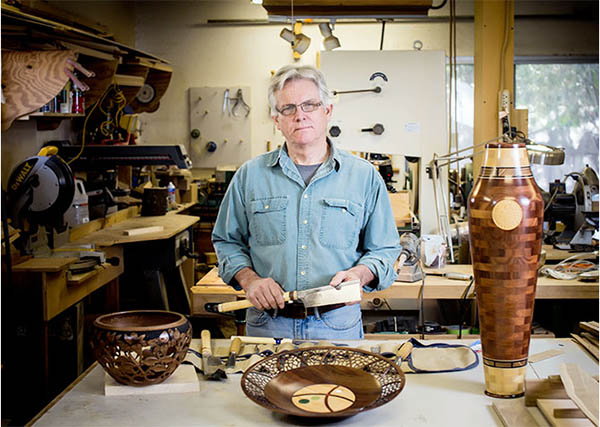
Although Gene Kelly “never left doing woodworking” after his introduction to it in junior high woodworking classes, “I just never allowed myself to do it as a full-time profession” – until a few years ago.
Gene, who spent some time working as a general contractor, said, “You get to a point where you’re making chairs for a restaurant, and that’s OK, but you realize ‘That’s not me; that’s for the restaurant.’ I need to build something I’m interested in.”
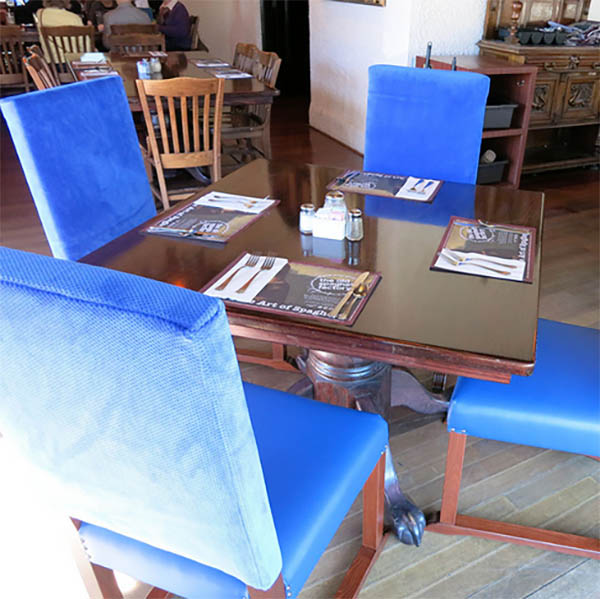
For Gene, right now, what he’s interested in building is furniture and wood art, particularly sculptured furniture, along the lines of the types of projects built by the late Sam Maloof, and segmented turnings.
“There are people doing cabinetry and making money at it, and I think that’s great, but I’d be bored to tears. I have to really challenge myself,” Gene said. “I’m always looking not only for something that’s pretty and nice to look at, but something that challenges me from where I’ve been before.”
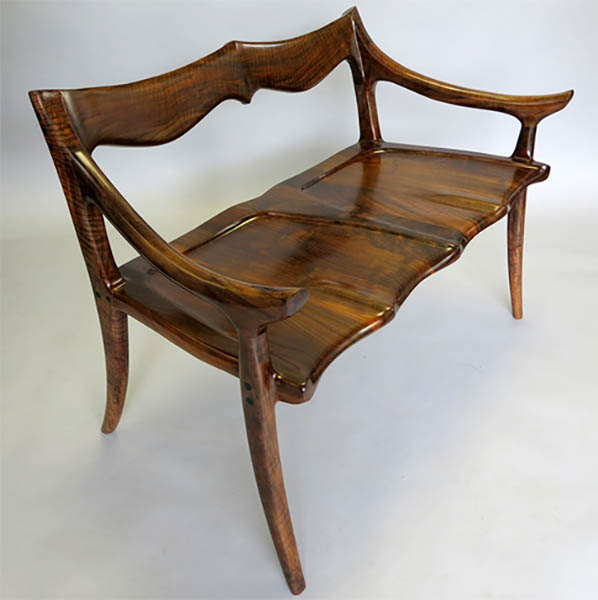
In the beginning, that’s what spurred his interest in sculptured furniture: it was something that he hadn’t done earlier. “I needed to understand the process of how you get from a very rough-cut piece of wood that’s been cut and dried and put in your shop and then becomes a piece of furniture that appears to be seamless.”
Appearing to be seamless? “I have people come into the shop and look at [a project] and ask, ‘Is this just one piece of wood?’” Gene said. “I have to remind myself that they’re serious.”
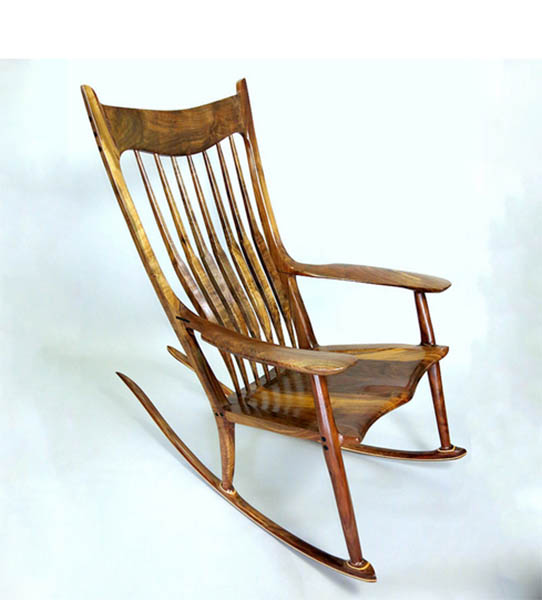
He takes inspiration both from Sam Maloof’s work, and from his working philosophy. “I really bow down to what he did with wood, and his thought process. It was a very spiritual process for him. I really appreciate his view of the reason things look good: they are like life, they should flow. I always want to be able to keep in mind that your life should be reflected in everything you do.”
Gene also appreciates the learning process. At one point, he worked for a company that made decorative stair rails and balustrades, “the type of balustrade that you couldn’t make without doing a piece at a time and putting it together on-site,” he said. “It went a long way in my education about wood.”
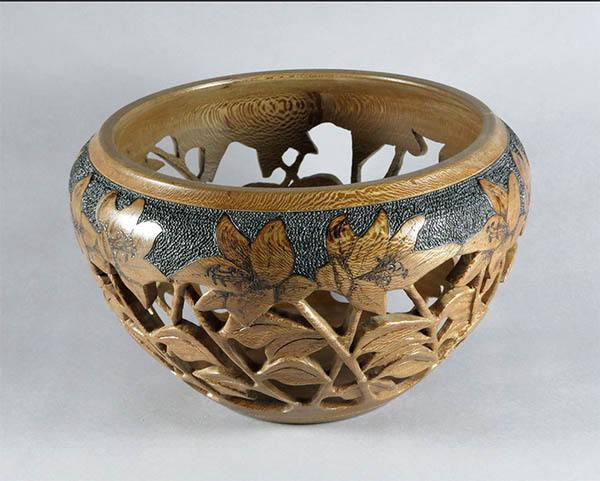
A brief experience building a violin under the mentorship of another woodworker in Sacramento was also “really educational for me in how wood works, and how to work with wood,” Gene said, noting that these are two different things. When looking at how to work with wood, “you can’t just ‘have your way with’ wood,” he said.
And, in terms of how wood works, “There are many reasons for different woods, from different sources. I’m learning more about them all the time, and it’s really fascinating for me.”
Wood selection is also an area where Gene feels he has some natural talent. “I become very involved in the wood. Maybe a particular piece of wood doesn’t necessarily work for a particular project. It’s all in being able to look at the wood and see what it’s good for and what it’s not good for.” For example, he is making a baseball bat for a grandchild for Christmas and had two pieces of hard maple as options. One was a good piece, and one was filled with tiny knots that would cause problems with the bat. “You have to be able to see that,” Gene said.
For many of his furniture projects, he uses locally sourced Claro walnut and California black walnut, but he also enjoys employing exotics in his segmented turnings. One of those turnings incorporated 1,400 pieces – part of Gene’s learning process.
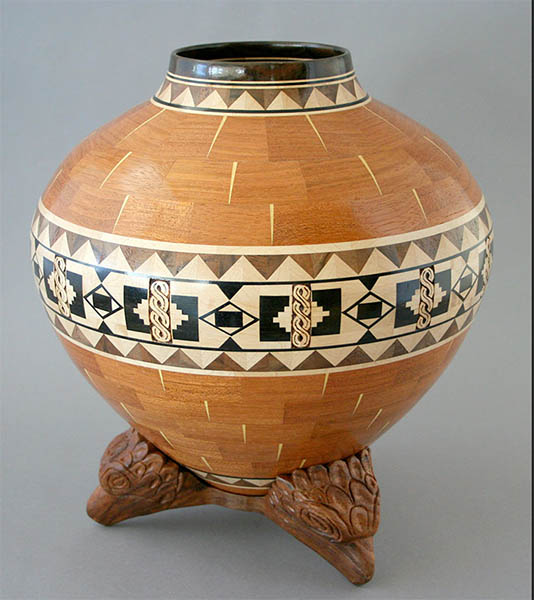
At first, he said, “I learned how to turn things on a lathe: you take a big piece of wood and you turn it into a bowl or a table leg. So, I can turn stuff and make it look pretty good. Now, it’s how to get from one piece of wood to 1,400 pieces glued together and have it turn out to be something that people like.”
Not that “like” is necessarily the reaction he’s going for. “I’m always looking forward to a project, and it’s hard for me to describe to someone what it’s going to look like until it’s done. And then, hopefully, it will make them smile or make them feel something – not just ‘Oh, that’s nice.’ but ‘Wow! That’s interesting!’”
Current works in progress include a basswood mirror frame with carvings of classical elements like “angels, cherubs, storms at sea”; and a sculptural table that is more of an art piece, incorporating a carved tablecloth and the legs carved to represent the hind end of an elephant.
It’s likely a far cry from the type of woodworking he was doing 30 years ago, like building a cradle for his infant daughter or a spice cabinet for the kitchen. Still, Gene said, a constant since those projects is the support of his family, including his wife, Lee Marie. “I appreciate them more than I am able to express to them.”
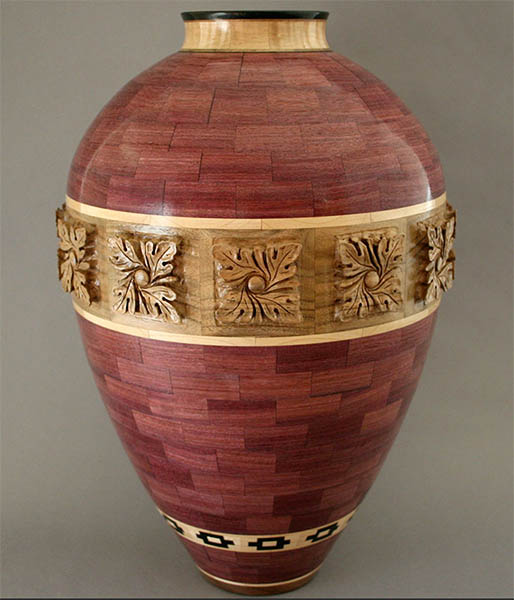
As to his woodworking? “I’m headed toward straight-out large sculptures: I can see that in my future,” he said. That may be how he answers his own question to himself of “How do I make this dissimilar to what other people do?”
Carving medallions into some of his segmented turnings has been one answer to that question so far. “I’m always trying to make a project more difficult, take a different form from what other people are doing,” he said. “I want to get away from other people’s designs, and let it evolve to a point where now it’s my design.
“Generally, my process is always going from something to something harder, or something I haven’t done before. I’m always interested in doing the next project.”







